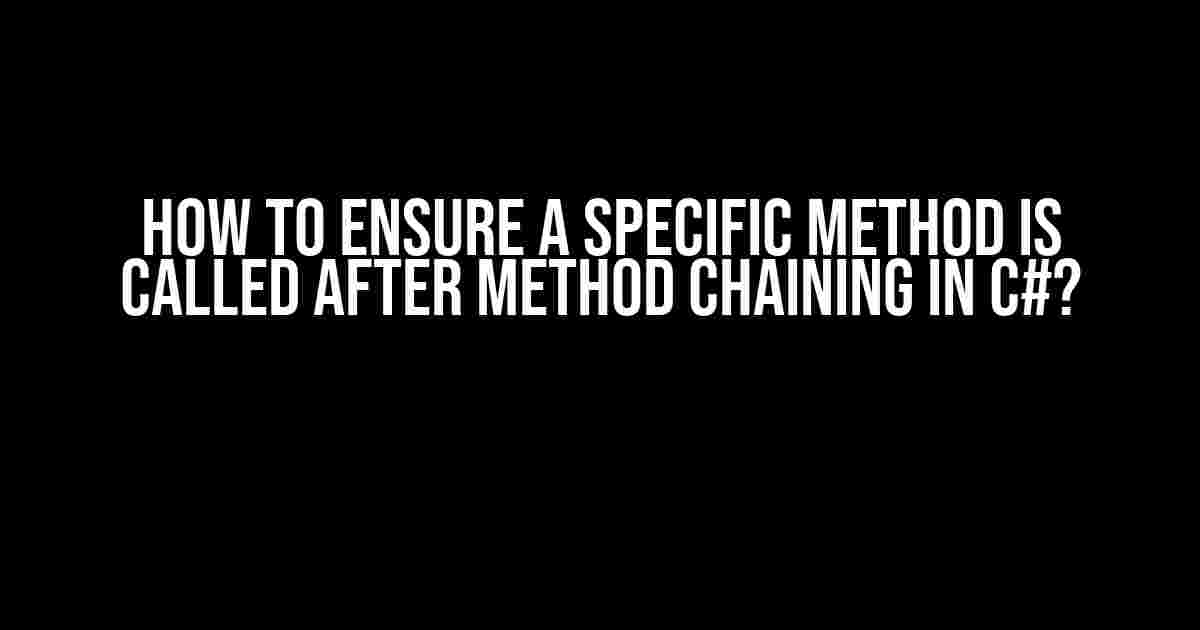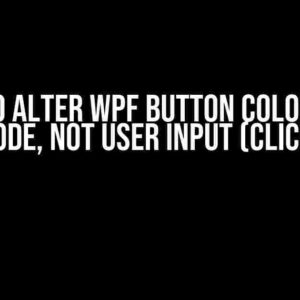Method chaining, a fundamental concept in C#, allows developers to chain multiple method calls together, creating a fluent interface that is both intuitive and efficient. However, as our interfaces grow in complexity, ensuring that a specific method is called after method chaining can become a daunting task. Fear not, dear developer, for we shall embark on a journey to uncover the secrets of method chaining and explore the various techniques to guarantee the execution of a specific method in C#.
Understanding Method Chaining
Method chaining is a design pattern that enables developers to create a sequence of method calls, where each method returns an instance of the same class, allowing the next method to be called on the returned instance. This pattern is commonly used in C# to create fluent interfaces, making the code more readable and maintainable.
public class Calculator
{
private int result;
public Calculator Add(int value)
{
result += value;
return this;
}
public Calculator Subtract(int value)
{
result -= value;
return this;
}
public int GetResult()
{
return result;
}
}
// Usage:
Calculator calculator = new Calculator();
int result = calculator.Add(5).Subtract(2).GetResult();The Problem: Ensuring a Specific Method is Called
While method chaining provides a elegant way to perform a series of operations, it can be challenging to ensure that a specific method is called after the chaining process. In the example above, we want to guarantee that the `GetResult()` method is called at the end of the chaining sequence. Failure to do so may lead to unexpected behavior or errors in our application.
Techniques to Ensure a Specific Method is Called
Now that we’ve identified the problem, let’s explore the various techniques to ensure a specific method is called after method chaining in C#:
1. Interface-based Approach
One approach is to define an interface that forces the implementation of the specific method. This interface can be used as a contract, ensuring that any class implementing it will have to provide an implementation for the required method.
public interface I Calculator
{
int GetResult();
}
public class Calculator : ICalculator
{
// ... implementation ...
public int GetResult()
{
// implementation
}
}By using this interface, we can ensure that any class implementing it will have to provide an implementation for the `GetResult()` method.
2. Abstract Base Class
Another approach is to create an abstract base class that provides a default implementation for the specific method. This way, any derived classes will inherit the implementation and ensure that the method is called.
public abstract class CalculatorBase
{
public abstract int GetResult();
public CalculatorBase Add(int value)
{
// implementation
return this;
}
public CalculatorBase Subtract(int value)
{
// implementation
return this;
}
}
public class Calculator : CalculatorBase
{
// ... implementation ...
}By using an abstract base class, we can provide a default implementation for the `GetResult()` method, ensuring that it’s called in any derived classes.
3. Fluent Interface with Terminal Method
A fluent interface can be designed to include a terminal method that performs the necessary operation and returns a value. This approach ensures that the terminal method is always called at the end of the chaining sequence.
public class Calculator
{
private int result;
public Calculator Add(int value)
{
result += value;
return this;
}
public Calculator Subtract(int value)
{
result -= value;
return this;
}
public int Calculate()
{
return result;
}
}
// Usage:
Calculator calculator = new Calculator();
int result = calculator.Add(5).Subtract(2).Calculate();In this example, the `Calculate()` method is designated as the terminal method, ensuring that it’s called at the end of the chaining sequence.
4. Builder Pattern
The Builder pattern provides a separate class responsible for constructing an object step-by-step, allowing for more flexibility and control over the construction process. This pattern can be used to ensure that a specific method is called after method chaining.
public class CalculatorBuilder
{
private Calculator calculator;
public CalculatorBuilder Add(int value)
{
calculator.Add(value);
return this;
}
public CalculatorBuilder Subtract(int value)
{
calculator.Subtract(value);
return this;
}
public int Build()
{
return calculator.GetResult();
}
}
public class Calculator
{
private int result;
public Calculator Add(int value)
{
result += value;
return this;
}
public Calculator Subtract(int value)
{
result -= value;
return this;
}
public int GetResult()
{
return result;
}
}
// Usage:
CalculatorBuilder builder = new CalculatorBuilder();
int result = builder.Add(5).Subtract(2).Build();In this example, the `CalculatorBuilder` class is responsible for constructing the `Calculator` object, ensuring that the `GetResult()` method is called at the end of the chaining sequence.
Conclusion
In this article, we’ve explored the various techniques to ensure a specific method is called after method chaining in C#. By using interface-based approaches, abstract base classes, fluent interfaces with terminal methods, or the Builder pattern, developers can guarantee the execution of a specific method in C#. Remember, method chaining is a powerful tool in C#, but it requires careful consideration to ensure that the desired behavior is achieved.
By implementing these techniques, you’ll be able to create more robust, maintainable, and efficient code that meets the requirements of your application. So, the next time you’re faced with the challenge of ensuring a specific method is called after method chaining, remember the techniques outlined in this article and take your C# coding skills to the next level!
| Technique | Description |
|---|---|
| Interface-based Approach | Use an interface to force the implementation of the specific method |
| Abstract Base Class | Use an abstract base class to provide a default implementation for the specific method |
| Fluent Interface with Terminal Method | Design a fluent interface with a terminal method that performs the necessary operation and returns a value |
| Builder Pattern | Use the Builder pattern to ensure that the specific method is called after method chaining |
Remember, the choice of technique depends on the specific requirements of your application and the complexity of your interface. By following these guidelines and understanding the underlying principles, you’ll be well on your way to mastering method chaining in C#.
- Understand the problem: Identify the need to ensure a specific method is called after method chaining
- Choose a technique: Select the most suitable technique based on the requirements of your application
- Implement the technique: Implement the chosen technique to ensure the specific method is called
- Test and refine: Test your implementation and refine it as necessary to ensure the desired behavior
By following these steps and using the techniques outlined in this article, you’ll be able to create robust, maintainable, and efficient code that meets the requirements of your application. Happy coding!
Frequently Asked Question
Ever wondered how to ensure a specific method is called after method chaining in C#?
How to ensure a specific method is called after method chaining in C#?
You can use the fluent interface pattern to ensure a specific method is called after method chaining in C#. This involves returning the object being chained from each method, allowing the next method in the chain to be called.
What is the fluent interface pattern in C#?
The fluent interface pattern is a software design pattern that provides a fluid and readable way to perform complex operations by method chaining. It’s achieved by having each method return the object it’s being called on, allowing the next method in the chain to be called.
Can I use extension methods to ensure a specific method is called after method chaining in C#?
Yes, you can use extension methods to ensure a specific method is called after method chaining in C#. Extension methods allow you to add new functionality to existing types without modifying them. By creating an extension method, you can add a new method to the end of a chain that will be called automatically.
How do I handle errors when using method chaining in C#?
When using method chaining in C#, it’s essential to handle errors properly to avoid unexpected behavior. You can use try-catch blocks or error handling mechanisms like Guards to handle errors and exceptions. Additionally, consider using design patterns like the Null Object Pattern to avoid null reference exceptions.
What are some best practices for using method chaining in C#?
Some best practices for using method chaining in C# include keeping methods short and focused on a single task, using descriptive method names, and avoiding complex logic within the chain. Additionally, consider using a consistent naming convention and documenting your code to make it easier for others to understand.




